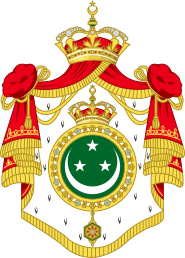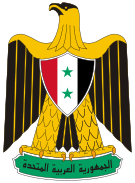Coat of arms
| Part of aserieson |
| Heraldicachievement |
|---|
| External devices in addition to the centralcoat of arms |
|
|
Acoat of armsis aheraldicvisual design[1]on anescutcheon(i.e.,shield),surcoat,ortabard(the latter two being outer garments). The coat of arms on an escutcheon forms the central element of the fullheraldic achievement,which in its whole consists of a shield,supporters,acrest,and amotto.A coat of arms is traditionally unique to thearmiger(e.g. anindividual person,family,state,organization,schoolorcorporation). The term "coat of arms" itself, describing in modern times just the heraldic design, originates from the description of the entire medieval chainmail "surcoat" garment used in combat or preparation for the latter.
Rolls of armsare collections of many coats of arms, and since theearly Modern Agecenturies, they have been a source of information for public showing and tracing the membership of anoble family,and therefore itsgenealogyacrosstime.
History[edit]
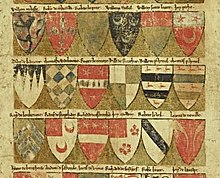
Heraldic designs came into general use among European nobility in the 12th century. Systematic, heritable heraldry had developed by the beginning of the 13th century. Exactly who had a right to use arms, by law orsocial convention,varied to some degree between countries. Early heraldic designs were personal, used by individual noblemen (who might also alter their chosen design over time). Arms become hereditary by the end of the 12th century, in England by KingRichard Iduring theThird Crusade(1189–1192).[2][3]
Burgher armswere used in Northern Italy in the second half of the 14th century, and in theHoly Roman Empire by the mid 14th century. In the late medieval period, use of arms spread to the clergy, to towns as civic identifiers, and to royally chartered organizations such as universities and trading companies. The arts ofvexillologyand heraldry are closely related.
The termcoat of armsitself in origin refers to thesurcoatwith heraldic designs worn by combatants, especially in theknightly tournament,in Old Frenchcote a armer.The sense is transferred to the heraldic design itself in Middle English, in the mid-14th century.[4]
Despite no common, enforceable widespread regulation,[citation needed]heraldry has remained consistent across Europe, where tradition alone has governed the design and use of arms.[5][citation needed]Some nations, such asEnglandandScotland,still maintain the sameheraldic authoritieswhich have traditionally granted and regulated arms for centuries and continue to do so in the present day. In England, for example, the granting of arms is and has been controlled by theCollege of Arms.Unlikesealsand other generalemblems,heraldic "achievements" have a formal description called ablazon,which uses vocabulary that allows for consistency in heraldic depictions. In the present day, coats of arms are still in use by a variety of institutions and individuals: for example, many European cities and universities have guidelines on how their coats of arms may be used, and protect their use astrademarksas any other unique identifier might be.[6][7]Many[citation needed]societies exist that also aid in the design and registration of personal arms.


Heraldry has been compared to modern corporatelogos.[8]
Regional traditions[edit]
French heraldry[edit]
The French system of heraldry greatly influenced the British andWestern Europeansystems. Much of the terminology and classifications are taken from it. However, with the fall of the French monarchy (and later Empire) there is not currently aFons Honorum(power to dispense and control honors) to strictly enforce heraldic law. The French Republics that followed have either merely affirmed pre-existing titles and honors or vigorously opposed noble privilege. Coats of arms are considered an intellectual property of a family or municipal body. Assumed arms (arms invented and used by the holder rather than granted by an authority) are considered valid unless they can be proved in court to copy that of an earlier holder.
British heraldry[edit]

In the heraldic traditions ofEnglandandScotland,an individual, rather than a family, had a coat of arms. In those traditions coats of arms are legal property transmitted from father to son;wives and daughterscould also bear arms modified to indicate their relation to the current holder of the arms.Undifferenced armsare used only by one person at any given time. Other descendants of the original bearer could bear the ancestral arms only with somedifference:usually a colour change or the addition of a distinguishingcharge.One such charge is thelabel,which in British usage (outside theRoyal Family) is now always the mark of anheir apparentor (in Scotland) anheir presumptive.Because of their importance in identification, particularly in seals on legal documents, the use of arms was strictly regulated; few countries continue in this today. This has been carried out byheraldsand the study of coats of arms is therefore called "heraldry". In time, the use of arms spread from military entities to educational institutes, and other establishments.[6]
In Scotland, theLord Lyon King of Armshascriminal jurisdictionto control the use of arms. In England,Northern IrelandandWalesthe use of arms is a matter ofcivil lawand regulated by theCollege of Armsand theHigh Court of Chivalry.
In reference to a dispute over the exercise of authority over the Officers of Arms in England,Arthur Annesley, 1st Earl of Anglesey,Lord Privy Seal,declared on 16 June 1673 that the powers of theEarl Marshalwere "to order, judge, and determine all matters touching arms, ensigns of nobility, honour, and chivalry; to make laws, ordinances, and statutes for the good government of the Officers of Arms; to nominate Officers to fill vacancies in the College of Arms; to punish and correct Officers of Arms for misbehaviour in the execution of their places". It was further declared that no patents of arms or any ensigns of nobility should be granted and no augmentation, alteration, or addition should be made to arms without the consent of the Earl Marshal.
Irish heraldry[edit]

InIrelandthe usage and granting of coats of arms was strictly regulated by theUlster King of Armsfrom the office's creation in 1552. After Irish independence in 1922 the office was still functioning and working out ofDublin Castle.The last Ulster King of Arms wasSir Nevile Rodwell Wilkinson[Ulster King of Arms 1908–1940], who held it until his death in 1940. At the Irish government's request, no new King of Arms was appointed.Thomas Ulick Sadleir,the Deputy Ulster King of Arms, then became the Acting Ulster King of Arms. He served until the office was merged with that ofNorroy King of Armsin 1943 and stayed on until 1944 to clear up the backlog.

An earlierIreland King of Armswas created byKing Richard IIin 1392 and discontinued byKing Henry VIIin 1487. It did not grant many coats of arms – the few it did grant were annulled by the other Kings of Arms because they encroached upon their jurisdictions. Its purpose was supposedly to marshal an expedition to fully conquer Ireland that never materialized. Since 1 April 1943 the authority has been split between theRepublic of IrelandandNorthern Ireland.Heraldry in the Republic of Ireland is regulated by theGovernment of Ireland,by theGenealogical Officethrough the Office of theChief Herald of Ireland.Heraldry in Northern Ireland is regulated by theBritish Governmentby theCollege of Armsthrough theNorroy and Ulster King of Arms.
German heraldry[edit]

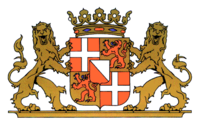
The heraldic tradition andstyleof modern and historic Germany and theHoly Roman Empire– including national and civic arms, noble andburgher arms,ecclesiastical heraldry, heraldic displays, and heraldic descriptions – stand in contrast to Gallo-British, Latin and Eastern heraldry, and strongly influenced the styles and customs of heraldry in theNordic countries,which developed comparatively late.[9]
[edit]
In theNordic countries,provinces, regions, cities, and municipalities have coats of arms. These are posted at the borders and on buildings containing official offices, as well as used in official documents and on the uniforms of municipal officers. Arms may also be used on souvenirs or other effects, given that an application has been granted by the municipal council.
Other national traditions[edit]

At a national level, "coats of arms" were generally retained by European states with constitutional continuity of more than a few centuries, including constitutional monarchies likeDenmarkas well as old republics likeSan MarinoandSwitzerland.
InItalythe use of coats of arms was only loosely regulated by the states existing before theunificationof 1861. Since theConsulta Araldica,thecollege of armsof theKingdom of Italy,was abolished in 1948, personal coats of arms and titles of nobility, though not outlawed, are not recognised.
Coats of arms inSpainwere generally left up to the owner themselves, but the design was based on military service and the heritage of their grandparents. InFrance,the coat of arms is based on theFleur-de-lysand theRule of Tincturesused in English heraldry as well.
North American[edit]
Canada[edit]
Themonarch of Canada'sprerogative to grant armorial bearings has been delegated to theGovernor General of Canada.Canada has its ownChief HeraldandHerald Chancellor.TheCanadian Heraldic Authority,the governmental agency which is responsible for creating arms and promoting Canadian heraldry, is situated atRideau Hall.[10][11]
United States[edit]

TheGreat Seal of the United Statesuses on the obverse as its central motif a heraldic achievement described as being the arms of the nation.[12]The seal, and the armorial bearings, were adopted by theContinental Congresson 20 June 1782, and is a shield divided palewise into thirteen pieces, with a blue chief, which is displayed upon the breast of an American bald eagle. The crest is thirteen stars breaking through a glory and clouds, displayed with no helm, torse, or mantling (unlike most European precedents). Only a few of theAmerican stateshave adopted a coat of arms, which is usually designed as part of therespective state's seal.Vermonthas both astate sealand astate coat of armsthat are independent of one another (though both contain a pine tree, a cow and sheaves of grain); the seal is used to authenticate documents, whilst the heraldic device represents the state itself.
Ecclesiastic heraldry[edit]
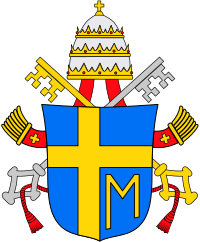
TheVatican City Stateand theHoly Seeeach have their owncoat of arms.As the papacy is not hereditary, its occupants display their personal arms combined with those of their office. Somepopescame fromarmigerous(noble) families; others adopted coats of arms during their career in the Church. The latter typically allude to their ideal of life, or to specific pontifical programmes.[13]A well-known and widely displayed example in recent times wasPope John Paul II's arms. His selection of a large letter M (for theVirgin Mary) was intended to express the message of his strongMariandevotion.[14]Roman Catholicdiocesesare also each assigned a coat of arms, as arebasilicasor papal churches, the latter usually displaying these on the building. These may be used in countries which otherwise do not use heraldic devices. In countries like Scotland with a strong statutory heraldic authority, arms will need to be officially granted and recorded.
Flags and banners[edit]
Flagsare used to identify ships (where they are calledensigns), embassies and such, and they use the samecolorsand designs found in heraldry, but they are not usually considered to be heraldic. A country may have both anational flagand a national coat of arms, and the two may not look alike at all. For example, theflag of Scotland(St Andrew's Cross) has a whitesaltireon a bluefield,but theroyal arms of Scotlandhas a red lion within a doubletressureon agold (or)field.
Modern national emblems[edit]
Among the states ruled by communist regimes, emblemsresembling those of the Soviet stateswere adopted in all theWarsaw Pactstates exceptCzechoslovakiaandPoland.Since 1986–1989, some of the ex-Communist states,such asRussia,have reused their original pre-communist heraldry, often with only the symbols of monarchy removed. Other countries such asBelarushave retained their communist coats of arms or at least kept some of the old heraldry.
With the independence of the modern nation states of theArab Worldfrom the First World War onwards, European traditions of heraldry were partially adopted for state emblems. These emblems often involve thestar and crescentsymbol taken from theOttoman flag. Other commonly seen symbols are birds, chiefly theEagle of Saladin,[15]and theHawk of Quraish.[citation needed]These symbols can be found on thecoat of arms of Egypt,andSyria,amongst others.
Sub-Saharan African flags and emblemsafterdecolonisationoften chose emblems based on regional traditions or wildlife. Symbols of a ritual significance according to local custom were generally favoured, such as theleopardin the arms ofBenin,Malawi,Somalia,theDemocratic Republic of the Congoand, in the form of the black panther, ofGabon.
InKenya,theSwahiliwordHarambee(lit. "Let us come together" ) is used as a motto in the country's coat of arms. InBotswanaandLesotho,meanwhile, the wordPula(lit. "Rain" ) is used in like fashion.
In the coat of arms ofEswatini,alionand anelephantserve as supporters. They are each intended to represent the king and the queen mother respectively, the nation's joint heads of state.
Comparable traditions outside of Europe[edit]

Japanese emblems, calledkamon(often abbreviated "mon" ), are family badges which often date back to the 7th century, and are used in Japan today. The Japanese tradition is independent of the European, but many abstract and floral elements are used.
See also[edit]
- Arms of assumption
- Armorial of UK universities
- Baron and feme
- Gallery of country coats of arms
- List of coats of arms
- National emblem
- Officer of arms
- Seal
- Siebmachers Wappenbuch(coats of arms from German-speaking regions)
References[edit]
Citations[edit]
- ^McQuarrie, Edward F.; Phillips, Barbara J. (30 December 2016).Visual Branding: A Rhetorical and Historical Analysis.Edward Elgar Publishing.ISBN978-1-78536-542-3.
- ^Aivars Gulbis (24 May 2017)."Baron fon Bury's Grave in Ugāle hillfort".redzet.eu.Retrieved22 May2020.
- ^McDonald, James."International Heraldry".Castles and Manor Houses.Archivedfrom the original on 4 October 2023.
- ^"coat of arms | Etymology of phrase coat of arms".etymonline.Archivedfrom the original on 1 August 2023.
- ^Friar, Stephen, ed. (1987).A New dictionary of heraldry.Sherborne: Alphabooks.ISBN0906670446.OCLC16094741.
- ^abMelewar, T.C.; Akel, Sibel (October 2005)."The role of corporate identity in the higher education sector".Corporate Communications.10(1). Emerald Insight: 41–57.doi:10.1108/13563280510578196.Archived fromthe originalon 1 September 2009.Retrieved26 August2015.
- ^"Policy on use of the Workmark and Insignia of McGill University"(PDF).McGill. 2000. Archived fromthe original(PDF)on 26 February 2015.Retrieved26 August2015.
- ^Employee Identification with the Corporate IdentityInternational Studies of Management and Organization, Volume 32, Number 3, 2002 "Group Identity Formation in the German Renaissance".20 August 2002. Archived fromthe originalon 20 January 2013.Retrieved26 August2015.
- ^Volborth, Carl-Alexander von (1981).Heraldry: Customs, Rules and Styles.Poole, England: Blandford Press.ISBN0-7137-0940-5.ISBN0-7137-0940-5p. 129.
- ^"The History of Heraldry in Canada".Royal Heraldry Society of Canada. 28 April 2004. Archived fromthe originalon 6 March 2009.Retrieved21 August2008.
- ^"Contact Us".Canadian Heraldic Authority. 23 December 2009. Archived fromthe originalon 11 September 2015.Retrieved26 August2015.
- ^"The Great Seal of the United States"(PDF).Bureau of Global Public Affairs. July 2003.Retrieved26 August2015.
- ^"Coat of arms of His Holiness Benedict XVI".The Holy See.Retrieved26 August2015.
- ^"Pontifical Insigna Flag, Coat of Arms and Seal of the Holy See and of the State of Vatican City".Vatican press office.9 June 2013.Retrieved27 August2015.
- ^Crespi, Zach (5 April 2011)."Coat of Arms (Eagle of Saladin)".The Egyptian Experience.Macaulay Honors College. Archived fromthe originalon 1 October 2015.Retrieved19 August2015.
Sources[edit]
- Pimbley, Arthur Francis (1908).Pimbley's dictionary of heraldry.Pimbley.
External links[edit]
 Media related toCoats of armsat Wikimedia Commons
Media related toCoats of armsat Wikimedia Commons- College of Arms– Repository of the coats of arms and pedigrees of English, Welsh, Northern Irish and Commonwealth families and their descendants together with, and in principle under the control of, the legal body theCourt of Chivalry,both medieval in origin.
- The Court of the Lord Lyon– the statutory heraldry office for Scotland (archived 5 June 2011)
- Royal Dutch Library page for the"Wapenboek Beyeren"– written by Claes Heynenzoon around 1400, containing over 1000 drawings of coats of arms.
- General armorial of noble families in the Russian Empire (Gerbovnik)(archived 22 March 2018)


